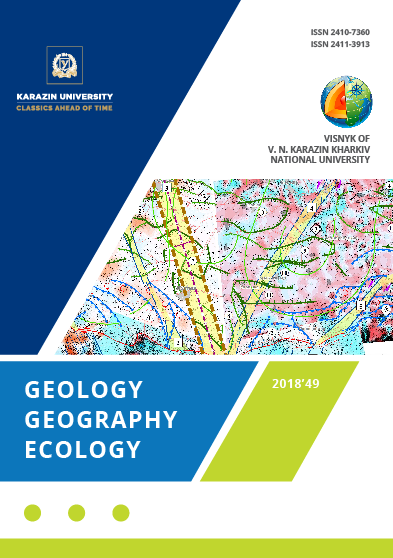Співвідношеня структурних елементів вуглеводневої складової аргілітів Східних Карпат за формалізмом Джейнса
Анотація
Частина осадових порід, що складають Східні Карпати, характеризуються значною насиченістю вуглеводнями. В літературі вони відомі під помилковою назвою "менілітові сланці", оскільки являють собою чорні та темно-сірі аргіліти, що складають менілітову світу оліroцену Внутрішньої зони Передкарпатського прогину і Складчастих Карпат.
Цей об’єкт зручний для вивчення, адже на поверхні наявні численні виходи менілітової світи, яка, окрім аргілітів, вміщує пісковики, алевроліти, мергелі, кремені із характерною домішкою силіцилів. Менілітова світа – потужне утворення, товщина якого сягає 1500 м. З вуглеводневою масою, накопиченою в ній, пов’язують близько 70% родовищ нафти Прикар-паття. Вміст органічного вуглецю по свиті складає у середньому 4-6%. Нами поставлено завдання дослідити будову біту-мів аргілітів менілітової світи та перерозподіл структурних елементах у вуглеводнях, який відбувається при зануренні, із збільшенням температури. Для виконання завдання застосовані методи рівноважної термодинаміки у сполучення із формалізмом Джейнса, який є частиною термодинаміки максимальної ентропії. Попередні роботи, що присвячені цій тема-тиці, спираються на модельні структури, які мають відображати усереднену молекулу бітуму. Із застосуванням цієї структури дослідники проводять розрахунки. З огляду на неоднорідність складу викопних вуглеводнів та нерегулярність будови розсіяної органічної речовини, такий підхід може вносити суттєві похибки у результати.
Спираючись на формалізм Джейнса, нами розроблена методика визначення вмісту функціональних груп у викопних вуглеводнях, як функції температури, спираючись лише на елементний склад зразку. Загалом, проводиться розрахунок відносної кількості 44 функціональних груп, відповідно до робіт ван Кревелена. Обчислення здійснювались в межах температур 300 – 600 К (27 – 327 °С), без ведення додаткових припущень.
Встановлено, що характер перерозподілу для окремих функціональних груп у загальному збігається з відомими експериментальними даними та відповідає сучасним уявленням про зміни структури викопних вуглеводнів із зануренням. Наявні невідповідності ймовірно будуть вирішені при введенні в розрахункову систему газів, які утворюються в процесі катагенезу.
Завантаження
Посилання
2. Chekalyuk E. B. (1971). Termodinamicheskiye osnovy teorii mineralnogo proiskhozhdeniya nefti [Thermodynamic principles of the theory of oils mineral origin]. – Kiyev, Ukraine: Naukova dumka, 256.
3. Chen, Y., Mastalerz, M., & Schimmelmann, A. (2012). Characterization of chemical functional groups in macerals across different coal ranks via micro-FTIR spectroscopy. International Journal of Coal Geology, 104, 22-33. doi:10.1016/j.coal.2012.09.001
4. Delvaux, D., Martin, H., Leplat, P., & Paulet, J. (1990). Comparative Rock-Eval pyrolysis as an improved tool for sedimentary organic matter analysis. Organic Geochemistry, 16(4-6), 1221-1229. doi:10.1016/0146-6380(90)90157-u
5. Gyulmaliyev A. M., Golovin G. S., Gladun T.G. (2003) Teoreticheskiye osnovy khimii uglya [Theoretical founda-tions of coal chemistry] Moskva, Russian Federation, 556.
6. Helgeson, H. C., Richard, L., Mckenzie, W. F., Norton, D. L., & Schmitt, A. (2009). A chemical and thermodynamic model of oil generation in hydrocarbon source rocks. Geochimica Et Cosmochimica Acta, 73(3), 594-695. doi:10.1016/j.gca.2008.03.004
7. Karpov I. K. (1981) Fiziko-khimicheskoye modelirovaniye na EVM v geokhimii [Physical-chemical computer mod-eling in geochemistry]. – Novosibirsk, Russian Federation: Nauka, 247.
8. Khokha Yu. V. (2014) Termodynamika hlybynnykh vuhlevodniv u prohnozuvanni rehiona-lnoi naftohazonosnosti [Thermodynamics of abyssal hydrocarbons in the forecast of oil and gas deposits]. Kyiv, Ukraine: Naukova dumka, 57.
9. Khokha Yu., Liubchak O., Khramov V. (2013) Termodynamichna model budovy orhanichnoi rechovyny vuhillia za yoho elementnym skladom [Thermodynamic model of the coals organic matter structure according to its element composition]. Geology and Geochemistry of Combustible Minerals, 1-2 (162-163), 71-78.
10. Koltun Yu., Espitalie J., Kot M. (1998). Petroleum Generation In The Ukrainian External Carpathians And The Adjacent Foreland. Journal of Petroleum Geology, 21, 265-288. doi:10.1306/bf9ab7a7-0eb6-11d7-8643000102c1865d
11. R. Sykesa, R. Snowdon (2002). Guidelines for assessing the petroleum potential of coal source rocks using Rock-Eval pyrolysis. Organic Geochemistry, 33, 1441-1455. doi: 10.1016/S0146-6380(02)00183-3
12. Kong, J., Wei, X., Yan, H., Li, Z., Zhao, M., Li, Y., & Zong, Z. (2015). Analysis of extractable basic nitrogen com-pounds in Buliangou subbituminous coal by positive-ion ESI FT-ICR MS. Fuel, 159, 385-391. doi:10.1016/j.fuel.2015.06.091
13. Van Krevelen D. W., Chermin H. A. G. (1951). Estimation of the free enthalpy (Gibbs free energy) in formation of organic compounds from group contributions. Chemical Engineering Science, 1(2), 66-80. doi: 10.1016/0009-2509(51)85002-4
14. Krupskyi Yu. Z., Kurovets I. M., Senkovskyi Yu. M. (2014) Netradytsiini dzherela vuhlevodniv [Unconventional sources of hydrocarbons of Ukraine]. Kyiv, Ukraine: Nika-Tsentr, 400.
15. Porfiriev V. B., Hrinberh Y. V., Ladyzhenskyi M. R. (1963) Menilitovi slantsi Karpat [Carpathians menilite shale's]. Kyiv, Ukraine: AN URSR, 136.
16. Li, W., Tang, Y., Zhao, Q., & Wei, Q. (2015). Sulfur and nitrogen in the high-sulfur coals of the Late Paleozoic from China. Fuel, 155, 115-121. doi:10.1016/j.fuel.2015.04.002
17. Lin, X., Wang, C., Ideta, K., Miyawaki, J., Nishiyama, Y., Wang, Y., Mochida, I. (2014). Insights into the functional group transformation of Chinese brown coal during slow pyrolysis by combining various experiments. Fuel, 118, 257-264. doi:10.1016/j.fuel.2013.10.081
18. Seewald, J. S. (1994). Evidence for metastable equilibrium between hydrocarbons under hydrothermal conditions. Nature, 370(6487), 285-287. doi:10.1038/370285a0
19. Traybus M. (1970) Termostatika i termodinamika [Thermostatics and Thermodynamics]. Moskva, Russian Federa-tion: Energiya, 504.
20. Qin, Z., Zhang, H., Dai, D., Zhao, C., & Zhang, L. (2014). Study on sulfur occurrence in different group components of Xinyu clean coking coal. Journal of Fuel Chemistry and Technology, 42(11), 1286-1294. doi:10.1016/s1872-5813(14)60050-5
21. Xin, H., Wang, D., Qi, X., Qi, G., & Dou, G. (2014). Structural characteristics of coal functional groups using quan-tum chemistry for quantification of infrared spectra. Fuel Processing Technology, 118, 287-295. doi:10.1016/j.fuproc.2013.09.011

Цю роботу ліцензовано за Міжнародня ліцензія Creative Commons Attribution 4.0.





